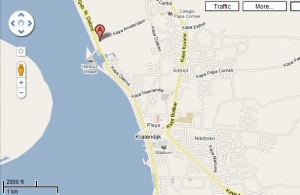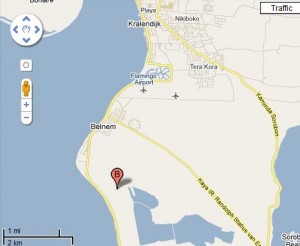Praise the Lord — not even one cutback in power on the transmitter last night or this morning! The water around the antennas is drying up and it appears the bugs are going away, too.
Just before 9am this morning I called (via the internet) the Technology Center in Elkhart and the men there were waiting for the truck to arrive with the container to pack the 50,000-watt AM transmitter for Swaziland. A short time later, news came that everything was now rescheduled for 9am on Wednesday.
For the rest of the morning at the office/studio, I repaired a VCR player that was giving problems, then searched for the equipment that I needed to proceed with repairs to the spare PA Module at the transmitter site. There are lots of tools and parts here, but, especially for a new person like me, it takes a while to locate what I need.
I stopped by our house* to eat dinner with Virginia. Often she will drive me to the site so she can have a car for the afternoon, but today she had a sore throat and decided she did not want to go anywhere. Pray that she will be able to fight off what ails her!
At the site, I managed to change the crowbar transistor on the filter board between the Modulator and RF Amplifiers. That board now seems to measure OK.
While I was doing this, Benny Saragoza, back for his first day from vacation, turned down the O.D. of a 5mm deep socket to 7mm. This was the tool I needed to take the transistors off the heat sink of the RF Amplifier. Actually I was amazed that a regular cutting tool could do this to a Craftsman socket. I thought the socket material would be harder than that and had been planning to use a Dremel motor with grinding wheel in place of the cutting tool on the lathe.
I then began the process of checking the transistors on the RF Amplifier. Since there are four in parallel, I took them off one at a time. Wouldn’t you know it, the first three that were removed were OK and the fourth was the bad one! Will also need to check a few more devices on the RF Amplifier board to make sure the one transistor is the only thing that is bad.
By this time, it was almost 5:30pm when the transmitter comes on, so I waited a few more minutes and completed some log readings. I then headed home for our 6pm swim, then a light supper.
Talked to Allan, Joyce and Mark on Skype this evening. Modern technology is amazing, especially when it comes to communicating.
*For reference, our house is about 1/2 mile south of the town of Kralendijk. The office/studio is about 1-1/2 mile north and the tranmitter site is about 6 miles south. Use this link:
http://maps.google.com/maps?f=q&source=s_q&hl=en&geocode=&q=Kralendijk,+Netherlands+Antilles&sll=41.621363,-85.915441&sspn=0.006657,0.01678&ie=UTF8&hq=&hnear=Kralendijk,+Bonaire,+Netherlands+Antilles&z=14
Or go to ‘www.maps.google.com’ and enter ‘Kralendijk, Netherlands Antilles’
 If you zoom in one click using ‘map’ view, you should see just south of the city center a label on the coast for Divi Flamingo Beach Resort. Our house is across the street and we use that beach for our evening swims.
If you zoom in one click using ‘map’ view, you should see just south of the city center a label on the coast for Divi Flamingo Beach Resort. Our house is across the street and we use that beach for our evening swims.

If you follow the main coast road north of Kralendijk you will come to a circle (the only one on the Google map, but there are now two more). TWR’s office/studio is on the SE corner. If you zoom
The transmitter site is a little harder to find, but if you use satellite view and go south of town and the airport on the coast road, you will see the outline of salt pans. If you zoom in on north side of the north-most salt pan along the road, you will see one large building and two smaller ones. If you look closely just north and west of the main building, it is possible to see the four towers, with shadows (the photo must have been taken around 8am), and the antenna tuning huts.
you zoom in on north side of the north-most salt pan along the road, you will see one large building and two smaller ones. If you look closely just north and west of the main building, it is possible to see the four towers, with shadows (the photo must have been taken around 8am), and the antenna tuning huts.
NOTE — To see a bigger (and in some cases, expanded) version of any of the images in this blog, just double click on the one you want to see.

